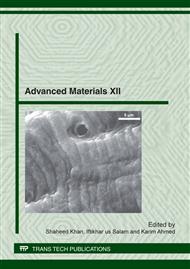[1]
B. Jaffe, R. S. Roth, and S. Marzullo: J. Appl. Phys. Vol. 25, (1954), pp.809-810.
Google Scholar
[2]
D. Berlincourt: J. Acoust. Soc. Am. Vol. 91(5), (1992), pp.3034-3040.
Google Scholar
[3]
S. Banerjee and R. N. Singh: Ferroelectrics. Vol. 211, (1998), pp.89-110.
Google Scholar
[4]
H. Zheng, I. M. Reaney, W. E. Lee, N. Jones and H. Thomas: J. Europ. Cer. Soc, Vol. 21, (2001), pp.1371-1375.
Google Scholar
[5]
N. Texier, C. Courtois, P. Champagne, A. Leriche: Mat. Lett. Vol. 58, (2004), pp.2489-2493.
Google Scholar
[6]
S. Linardos, Q. Zhang and J. R. Alcock: J. Europ. Cer. Soc. Vol. 26, (2006), p.117–123.
Google Scholar
[7]
C. Sangsubun, A. Watcharapasorn and S. Jiansirisomboon: Curr. App. Phy. Vol. 8, (2008), p.61–65.
Google Scholar
[8]
X. G. Tang, H. L. W . Chan, A. L and Ding, Q. R. Yin, Surf: Coat. Tech. Vol. 161, (2002), p.169–173.
Google Scholar
[9]
W. Nimmo, N. J. Ali, R. M. Brydson, C. Calvert, E. Hampartsoumian, D. Hind and S. J. Milne: J. Am. Ceram. Soc. Vol, 86(9), (2003), pp.1474-1480.
DOI: 10.1111/j.1151-2916.2003.tb03499.x
Google Scholar
[10]
A. Wu, I. M. Salvado, P. M. Vilarinho and J. L. Bapista: J. Am. Cer. Soc. Vol. 81(10), (1998), pp.2640-2644.
Google Scholar
[11]
L. G Hubert-Pfalzgraft: New J. of Chem. Vol. 11, (1987), p.663.
Google Scholar
[12]
J. Livage, M. Henry and C. Sanchez in: Sol-Gel Chemistry of Transition Metal Oxides, Volume 18, Progress in solid state chemistry, (1988).
DOI: 10.1016/0079-6786(88)90005-2
Google Scholar
[13]
C. Sanchez, J. Livage, M. Henry and F. Babonneau: J. Non-Cryst. Solids. Vol. 100, (1988), pp.65-76.
Google Scholar
[14]
C. Sanchez, F. Bpbonneau, and A. Leaustie in: Ultrastructure Processing of Advanced Ceramics, edited by J. D. Mackenzie and D.R. Ulrich Wiley, NY (1988).
Google Scholar
[15]
F. Bpbonneau, A. Leaustie and J. Livage in: Better ceramics Through Chemistry III, Mater. Res. Soc. Symp. Proc, 121, edited by C.J. Brinker, D. R. Ulrich Mater. Res. Soc. Pittsburgh, Pa, (1988).
Google Scholar
[16]
K. Kitaoka, H. Kozuka and T. Yoko: J. Am. Ceram. Soc. Vol. 81 (1998), p.1189–96.
Google Scholar
[17]
P. Tarte in: The Determination of Cation Co-ordination in Glasses by Infra-Red SpectroscopyI, edited by J. A. Prims Amsterdam: The Netherlands (1965).
Google Scholar
[18]
A. K. Zak, W. H. A. Majid: Cer. Int. Vol. 37, (2011), pp.753-758.
Google Scholar
[19]
K. S. Jacob, N. R. Panicker, I. P. Selvam and V. Kumar: J. Sol-gel. Sci and Tech. Vol. 28, (2003), p.289–295.
Google Scholar
[20]
C. J. Brinker, G. W. Scherer: Sol-gel Science: The Physics and Chemistry of Sol-Gel Processing (Academic Press, San Diego, 1990).
Google Scholar
[21]
M. Mai, C. Lin1, Z. Xiong1, H. Xue1and L. Chen: J. Phys.: Conf. Ser. Vol. 152, (2009), 012077.
Google Scholar


